This set of Heat Transfer Operations Multiple Choice Questions & Answers (MCQs) focuses on “Boilers – Boiling Curve Properties”.
1. The diameter of the bubble that gets detached from the heating surface during boiling can be found by which one of the following relations?
a) Stanton’s Relation
b) Fritz Relation
c) Fourier Theory
d) Nusselt’s Theory
View Answer
Explanation: The relation was given by Fritz, as given below-
D = Cd β [2 σ/g (ϸL – ϸV )]½, which is used to calculate the departing bubble diameter by knowing the values of surface tension and density.
2. Which one of the following conditions does not influence Nucleate pool boiling?
a) Pressure
b) Liquid properties
c) Heat capacity of fluid
d) Material of heating
View Answer
Explanation: The factors that determine the Nucleate boiling region are –
- Pressure
- Liquid properties
- Material of heating
3. The Fritz equation to calculate the bubble diameter is given by –
D = Cd β [2 σ/g (ϸL – ϸV )]½
What is the value of the constant Cd for water bubbles at 1atm?
a) 0.0148
b) 0.003
c) 0.0027
d) 0.00148
View Answer
Explanation: The equation to the bubble diameter for water bubbles at 1atm is
D = 0.0148 β [2 σ/g ( ϸL – ϸV )]½
4. Which one of the following is the correct representation of Fritz equation which is used to calculate bubble diameter in bubble pool boiling?
a) D = Cd β [2 σ/g (pt – pv)]½
b) D = Cd β [σ/g (pt – pv)]½
c) D = Cd β [2 σ/g (pt – pv)]2
d) D = Cd β [2 σ/g (pt – pv)]
View Answer
Explanation: The relation was given by Fritz, as given below-
D = Cd β [2 σ/g (ϸL – ϸV )]½, which is used to calculate the departing bubble diameter by knowing the values of surface tension and density along with the parameters Cd and β.
5. What is the significance of the term “ σ ” in the given Fritz Equation used to calculate bubble departure diameter?
D = Cd β [2 σ/g (PL – PV )]½
a) Surface Tension
b) Contact Angle
c) Liquid density
d) Gas density
View Answer
Explanation: The relation was given by Fritz, as given below-
D = Cd β [2 σ/g (PL – PV )]½, which is used to calculate the departing bubble diameter by knowing the values of surface tension σ and density difference ϸL – ϸV along with the parameters Cd and β.
6. The height of the superheated layer in nucleate boiling is __________ the diameter of the departing bubble.
a) Greater than
b) Less than
c) Equal to
d) Much greater than
View Answer
Explanation: The superheated region represented by the dotted lines is less than the diameter of bubble.

7. The size of the bubble on nucleation _________ as it rises up.
a) Increases
b) Decreases
c) Remains same
d) Breaks to many bubbles
View Answer
Explanation: The size increases due to the increasing vapour volume and also other bubbles coalesce into one another hence its size increases.
8. The correct representation of the bubble when it is about to depart is best represented by the diagram-
a) 
b) 
c) 
d) 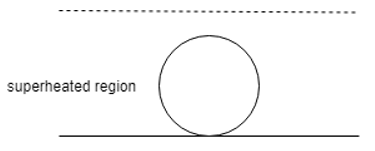
View Answer
Explanation: The Superheated region is always below the bubble diameter otherwise the bubble would further rise in size till it crosses the superheated region.
9. With increase in temperature of boiling operation, the heat transfer flux ___________
a) Decreases
b) Increases
c) Increases at first, then decreases
d) Increases at first, then decreases and later again increases
View Answer
Explanation: The boiling curve can be represented as –
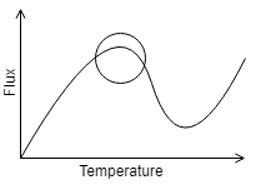
Where the flux first increases then decreases.
10. Which one of the following correctly represents the axes of the boiling curve?
a) Y: Heat flux and X: Temperature
b) X: Heat transfer coefficient and Y: Temperature
c) X: Heat flux and Y: Temperature
d) Y: Heat flux and X: Temperature difference
View Answer
11. The increase in heat flux after the Leiden Frost Point is due to ___________
a) Radiation
b) Convection
c) Conduction
d) Flash
View Answer
Explanation: The final region of heat flux growth/rise after the inefficient film boiling is called the radiation boiling region. Here the fluid is not in contact with the wall rather it is the radiation from the heating surface that is causing the temperature rise.
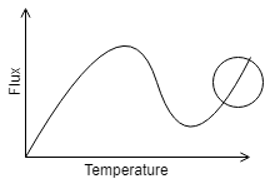
12. The Leiden Frost effect is observed in _________ of liquids.
a) Boiling
b) Cooling
c) Freezing
d) Radiation superheating
View Answer
Explanation: The region of minima of heat flux from the surface to the liquid after boiling the water/fluid is known as Leiden Frost Effect of the stable film boiling region because here exists a film that does not allow heat transfer.
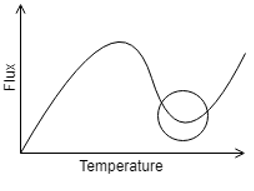
13. When the temperature of water is at about 90-100 degrees more than its boiling point, then what is the name of this type of boiling?
a) Nucleate
b) Stable Film boiling
c) Partially stable film boiling
d) Radiation boiling
View Answer
Explanation: This region is called the unstable region because the film has not yet formed completely and flickers from place to place, the heat flux further drops on increasing temperature.
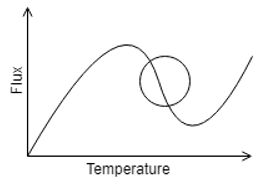
14. The temperature of operation of nucleate boiling is ___________ film boiling.
a) More than
b) Less than
c) Equal to
d) Difficult to be compared than
View Answer
Explanation: The region of nucleate boiling occurs before Critical flux whereas that of film boiling occurs after critical flux region.
15. Which one of the following statement is not correct about nucleate boiling?
a) The temperature of the surface is greater than the saturation temperature of the liquid
b) The heat flux is greater than film boiling
c) The temperature is greater than film boiling
d) Bubbles are created by the expansion of entrapped vapour in the heating surface
View Answer
Explanation: The region of nucleate boiling occurs before Critical flux whereas that of film boiling occurs after critical flux region. Hence the temperature of nucleate boiling is below film boiling.
Sanfoundry Global Education & Learning Series – Heat Transfer Operations.
To practice all areas of Heat Transfer Operations, here is complete set of 1000+ Multiple Choice Questions and Answers.
If you find a mistake in question / option / answer, kindly take a screenshot and email to [email protected]
- Practice Chemical Engineering MCQs
- Apply for Chemical Engineering Internship
- Check Chemical Engineering Books
- Check Heat Transfer Operations Books
